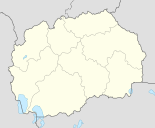Vaksince
| Vaksince Ваксинце Vaksinca / Vaksincë |
||||
|---|---|---|---|---|
|
||||
| Basic data | ||||
| Region : | Northeast | |||
| Municipality : | Kumanovo | |||
| Coordinates : | 42 ° 11 ' N , 21 ° 44' E | |||
| Height : | 394 m. i. J. | |||
| Residents : | 2,479 (2002) | |||
| Telephone code : | (+389) 031 | |||
| Postal code : | 1300 | |||
| License plate : | KU | |||
| Others | ||||
| City Festival : | 28th of May | |||
Vaksince ( Macedonian Ваксинце ; Albanian Vaksinca ) is an Albanian village in northern North Macedonia in the immediate vicinity of the Tabanovce border crossing into Serbia . The town of Kumanovo is located 10 km south of Vaksince .
The village was built on a mountain pass; Due to a lack of space and a steady increase in the number of inhabitants, it spread further and further into the lowlands. Vaksince has about 2500 inhabitants, all of whom are Albanian-speaking .
history
Ottoman Empire, Serbia, Yugoslavia, North Macedonia
Like the entire region of Macedonia, Vaksince belonged to the Ottoman Empire for centuries . When it fell apart at the beginning of the 20th century, Albania gained independence on November 28, 1912 , during which the majority of the citizens in and around Vaksince were in favor of their region belonging to this new state. But Serbia was able to get the great powers through that the Albanian settlement areas in Macedonia came largely under its rule, including Vaksince. Between 1918 and 1991 Vaksince belonged to Yugoslavia and since then to North Macedonia (until 2019 Republic of Macedonia).
The Macedonian-Albanian conflict in 2001
In 2001, Vaksince was one of the scenes of the Albanian Uprising in Macedonia . The place gained notoriety beyond the borders of the Republic of Macedonia because of the strong armed clashes between the Albanian insurgents, who belonged to the UÇK , and the Macedonian army . Albanian fighters killed two Macedonian soldiers and captured a third near the village. The Macedonian army then attacked Vaksince with attack helicopters and artillery fire. The Macedonian troops managed to shoot the commander of the Albanian insurgents, Fadil Nimani. After that the shelling of the place was stopped.
Overall, several Albanian civilians, two KLA fighters and several Macedonian soldiers and police officers were killed in the clashes over Vaksince. The two Albanian parties in Macedonia condemned the actions of the KLA and the endangerment of Albanian civilians from the army's artillery fire.
Afterwards, like other places in the region, Vaksince was closely observed by the international missions of the OSCE , NATO and the EU. Even after the clashes, the Macedonian army and police temporarily had no control over Vaksince. In autumn 2003 the village was again occupied by the Macedonian army.
To this day there are many Albanians in the region who want to join Kosovo . In September 2007 there was a shootout between former UÇK fighters and the Macedonian police. Two people were killed, including the commander of the regional police.
Vaksince as a symbolic place of Albanian nationalism
Since the conflict in 2001, Vaksince has been a symbol of the Albanian resistance against the North Macedonian state. In 2003 a memorial was erected for the killed Fadil Nimani. In 2005 a memorial was erected for Bajram Vaksinca, who in 1912 belonged to the fighters Dervish Caras, whose troops played an important role in the struggle for the independence of Albania. On November 28, 2008 - the day of the Albanian Declaration of Independence - a 4 m high statue was inaugurated next to the monument to Nimani.
Culture
Before the war, a library was inaugurated in the presence of various figures from Albanian literature .
literature
- Stephan Hensell: Typical Balkans? Patronage Networks, Ethnicity, and Dynamics of Violence in Macedonia. In: International Politics and Society 4/2003. Pp. 131-146.


